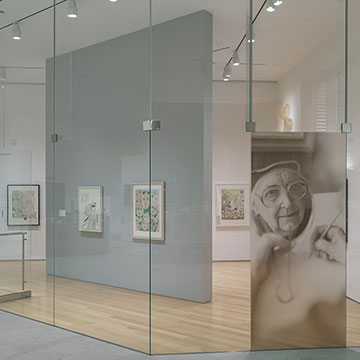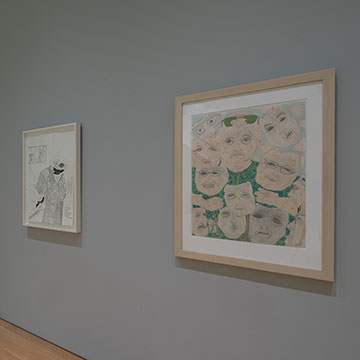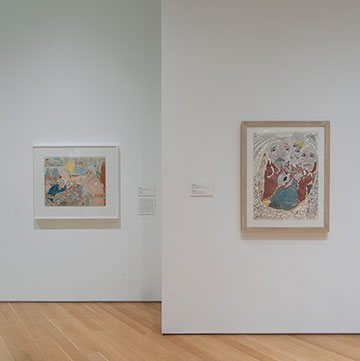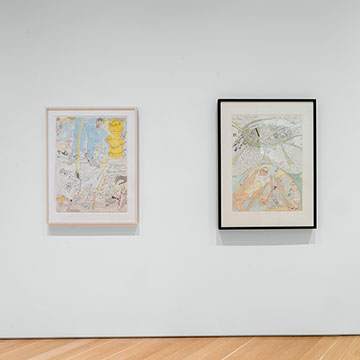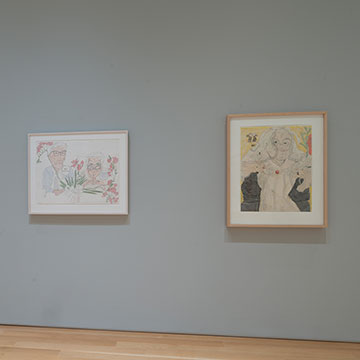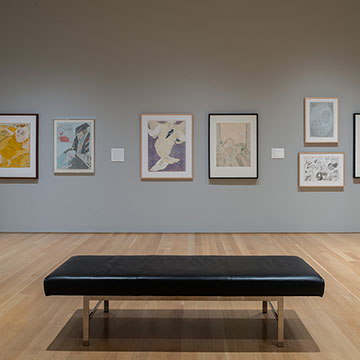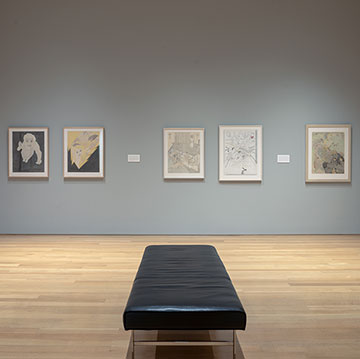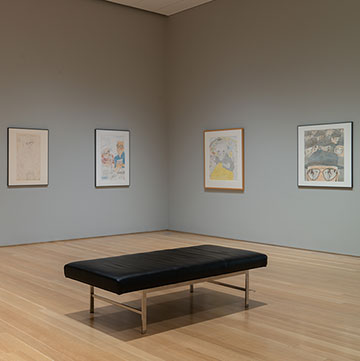Elizabeth Layton: Drawing as Discourse
On view January 25 through July 28, 2024
Elizabeth “Grandma” Layton (1909–1993), a Kansas artist active from the 1970s to early 1990s, began a contemplative drawing practice—coming to terms with her body, sense of identity, views, concerns, memories, and experiences—in 1977 at the age of sixty-eight.
In the sixteen years of her art-making, she returned to self-portraiture repeatedly. She centered her dimpling cellulite, accumulating sunspots, and wrinkling skin in numerous drawings—examining her appearance and exposing the onslaught of cultural commentary that scrutinized her and other senior women’s bodies. In other images, she harnessed drawing to process contemporary ethical discussions and unthinkable tragedies by imagining, for example, being a resident of an assisted living facility or suffering from fetal cocaine exposure amid the crack cocaine epidemic. And in gripping pictures of the throes of clinical depression, she depicted the isolation of suffering from mental illness and promoted mental healthcare.
Elizabeth Layton: Drawing as Discourse will celebrate Layton’s art with thirty of her works on paper, highlighting the way that her drawing desk was an intellectual, reflective, and advocatory space for her, where she shrewdly engaged with roaring ideological debates, studied art history, and confronted injustices of her time. The exhibition highlights this throughline in her art. She channeled self-portrait drawing into a space for discussion (mulling over her thoughts alone, sharing with friends and family, and eventually museum audiences), working through unresolved ideas, and processing her curiosity about the world.
Drawing as Discourse presents Layton’s inquisitive drawings and lithographs thematically. Sensitively, imaginatively, and boldly, Layton represented social justice issues that are as pressing today as they were in the 1970s and 80s. She addressed aggressive policing tactics, censorship in the arts amid the culture wars, and Anita Bryant’s “Save the Children” campaign, which villainized LGBTQIA+ communities. Layton also drew attention to public health epidemics, in addition to the surge of crack cocaine use; she brought empathy and nuance to conversations surrounding the AIDS crisis, which often relied upon dehumanizing homophobia. And she denounced detractors of the Equal Rights Amendment, like Phyllis Schlafly, who politicized motherhood, homemaking, and marriage. In dozens of images, Layton used self-portraiture to counter such rhetoric; she presented herself simultaneously as a cis white woman, mother, grandmother, wife to her husband Glenn, and resident of a small Kansas town, who fiercely opposed sexist, homophobic, ageist, and racist rhetoric.
Drawing as Discourse also considers Layton’s engagement with the arts. She read widely, particularly from newspapers (she edited her hometown paper, The Wellsville Globe), and she kept apprised not only of sociopolitical issues but popular culture and visual art, too. She studied art history independently and followed developments in contemporary art. The exhibition demonstrates how Layton pushed the limits of her formal education in her drawing practice to experience museums, heritage sites, and art happenings around the world imaginatively.
Though she did not reach Kansas City’s Loose Memorial Park to see Christo and Jeanne-Claude’s project, Wrapped Walk Ways, she collected newspaper clippings on the subject, acquired a scrap of the same fabric the artists used, and drew herself skipping down the nylon-covered sidewalk. And though she never visited Paris’s Musée du Louvre to see the ancient Hellenistic sculpture Winged Nike of Samothrace in person, she reimagined the famous sculpture’s gauzy tunic and supple marble form wearing a slip, panty hose, and orthopedic shoes, overtop the artist’s own varicose veined, knobby ankles.
The exhibition also showcases Layton’s extensive body of work on topics that are often taboo or painful to discuss, such as mortality, death, and what happens to us after we die. Some drawings picture her excruciating grief at the end of her son’s life, which he lost due to complications of alcoholism. On her drawing paper, she revisited her memories of being with her son in the intensive care unit, reflected on life support healthcare measures, and expressed the complex mourning of a parent surviving after their child has died. She also used drawing to imaginatively access what her own death would be like—both physically, for her corpse, and spiritually, for her soul—forecasting that it would be joyful transition into peace and serenity.
Taken together, the works in Elizabeth Layton: Drawing as Discourse echo conversations in U.S. culture today. Sexism, racism, ageism, ableism, fatphobia, the oppression of LGBTQIA+ individuals, censorship of artists, and the urgency of caring for mental illness—these are a mere handful of Layton’s numerous social concerns in her art. She rendered these subjects with her signature self-deprecating wit, insisting upon treating anyone who is downtrodden with empathy and educating oneself before casting judgment. Taking cues from the artist’s enduring interest in the power of art to inform, disarm, and engage, the exhibition presents Layton’s art as a space for discourse.
—Mary Frances Ivey, Guest Curator, Elizabeth Layton: Drawing as Discourse
PhD Candidate, Kress Department of Art History, University of Kansas
Sarachek Curatorial Fellow for Wiggins Studies, Wichita Art Museum
Explore Elizabeth Layton: Drawing as Discourse with our free digital guide. Download Bloomberg Connects on your phone today!

